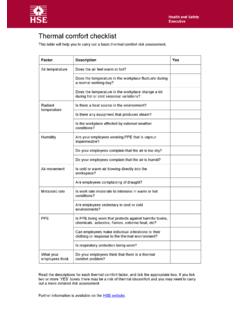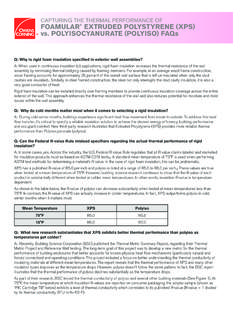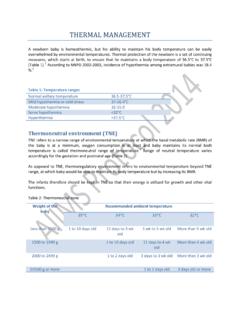Transcription of Introduction to thermal comfort standards - UTCI
1 19 Introduction to thermal comfort standardsK C ParsonsLoughborough University, UKAbstractThe aim of this paper is to describe existing ISO standards and current activityconcerned with thermal comfort . It describes how an ISO standard is produced froma new work item proposal (NP) to publication as an international standard (ISO). Aframework is provided for the assessment of ISO standards and their should be valid, reliable, useable, and with sufficient scope for practicalapplication.
2 The existing thermal comfort standard (ISO 7730) is considered in termsof these criteria as well as ISO 8996 (metabolic rate) and ISO 9920 (clothing). Theconsequences of inaccuracy in estimation of metabolic rate and clothing insulationshow that reasonable estimates can provide a range of thermal sensation work of ISO/TC 159 SC5, Ergonomics of the physical environment , ispresented in Appendix 1. Descriptions of ISO 7726 (instruments), ISO 10551(subjective measures), ISO TS 13732 Part 2 (contact with surfaces at moderatetemperature), ISO 14505 (vehicles), and ISO 14515 (people with specialrequirements) are described in Appendix.
3 standards , thermal comfortIntroductionThere are a number of national organizations whose standards have internationalinfluence and some make a contribution to the creation of knowledge of thermalcomfort and the application of that knowledge. For a standard to be trulyinternational however requires a co-ordination of countries and a process of commonconsent. The International standards Organization (ISO) was set up in 1947 and hasover 130 member countries.
4 Its principles of a single representative organizationfrom each country and a democratic system of voting support the notion of ademocratic process of globalization and a fairly operating world market in a worldeconomy. It is interesting that one of the major issues concerning thermal comfort isthe apparent conflict between a so called western approach, which attempts to seal a building and control the internal environment to constant levels of air temperatureappropriate to western behaviour and clothing, and an adaptive approach wherepeople can adapt to a wider range of conditions that complement their culture and inhot (or even cold) climates are less energy demanding.
5 The issue is more complex,however it demonstrates the advantage of international consensus over national trendsand interests. That is, an international organization with democratic processes willallow a broad international perspective to be aim of this paper is to provide an Introduction to ISO standards concerned withthermal comfort . The standards are described in the context of the ISO system forstandards production, existing ISO standards concerned with people in thermalenvironments, current thinking about future standards , and decisions that need to bemade to bring thermal comfort standards into the 21st century.
6 The paper is anintroductory paper to the Conference and, in particular, provides background to theproposed revision of ISO 7730, which is described by Dr Bjarne Olesen later in thisconference is an ISO standard produced?ISO standards are produced by experts from participating countries (P - members)according to agreed rules and a system of voting. There is a six-stage process fromthe initial idea for a standard to its final publication. This is shown in Table 1.
7 Six-stage process to the production of an International Standard (ISO)StageProcessDocument1 New work item proposal (TC, SC, WG, national,regional, organization, individual)New Proposal (NP)(Enquiry/Voting)2 Building expert consensus (WG)Working Document(WD)3 Consensus building across countries (TC, SC, WG)Committee Draft(CD)(Enquiry/Voting)4 Integration of comments and preparation of DraftInternational Standard (WG)Draft InternationalStandard (DIS)(Enquiry/Voting)5 Integration of editorial comments and preparation ofFinal Draft International Standard (WG)Final DraftInternationalStandard (FDIS)(Enquiry and Yes/Novote)6 Preparation of International Standard (Secretariat)InternationalStandard (ISO)Key:WG = Working Group ISO/TC 159 SC5 WG1 Ergonomics of the ThermalEnvironmentConvener: Dr Bjarne Olesen, DenmarkSC = Sub-Committee ISO/TC 159 SC5 Ergonomics of the Physical EnvironmentChairman: Professor Ken Parsons, UK.
8 Secretariat BSI: Dr Sina TalalTC = Technical Committee ISO/TC 159 ErgonomicsChairman: Wolfgang Schultetus, Germany; Secretariat DIN: Norbert BreutmannA thermal comfort standard is proposed (by a working group, committee or other) andsupported by a document that explains the requirement, the rationale and the scope ofthe proposed standard. The sub-committee (ISO/TC 159 SC5) then considers theproposal and submits it for international voting. On acceptance and an indication thatsufficient (5 ) member countries will participate in the work, the sub-committeeallocates the work to a working group (ISO/TC 159 SC5 WG1).
9 The working groupidentifies a project leader who develops working documents with advice andcomments from the international experts under the guidance and co-ordination of theconvener. A proposal to revise a standard would also be considered as a newproposal. All standards are reviewed every five years and, in the case of ISO 7730, itwas considered that significant developments had taken place since its adoption andthat a revision was required. The work was allocated by ISO/TC 159 SC5 to itsworking group on thermal environments (ISO/TC 159 SC5 WG1) with Dr BjarneOlesen as project leader.
10 Working documents have been produced and discussed at21meetings in Paris, Yokohama, Barcelona, Copenhagen and London. The document isnow proposed as a Committee Draft (ISO CD 7730). It is important at this stage tohave full international discussion about technical content so that the draft standardcan be modified to allow consensus (approval of two thirds of the P members voting).The Committee Draft (ISO CD 7730) is circulated to member countries who willcirculate it within their country and provide comments and a vote.





